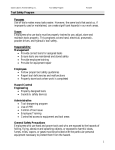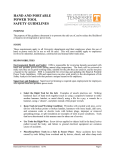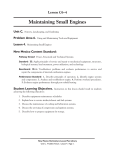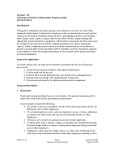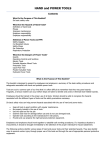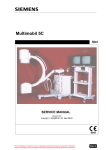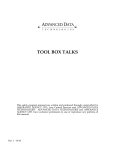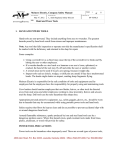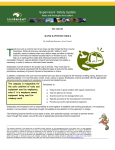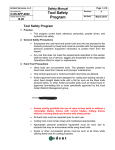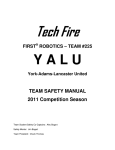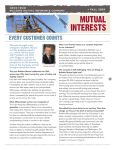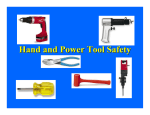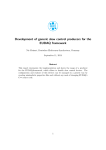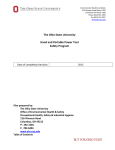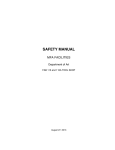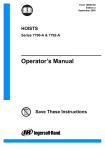Download Hand and Power Tool Program (Section 32) - Wagner
Transcript
Hand and Power Tool Program (Section 32) PURPOSE: The purpose of this procedure is to ensure that the employees of Wagner-Meinert, LLC, sub-contractors, company property, and host company property are properly protected against all occupational exposures to hand and power tools, in all forms, in all construction work where an employee may potentially be exposed. SCOPE: Tools are such a common part of our lives that it is difficult to remember that they may pose hazards. All tools are manufactured with safety in mind but, tragically, a serious accident often occurs before steps are taken to search out and avoid or eliminate toolrelated hazards. ASSOCITATED DOCUMENTS: APPENDIX 32A: Power Tools Checklist (Quarterly Inspection Checklist) REFERENCE: A) 29CFR 1926.300 General Requirements B 29CFR 1926.301 Hand Tools C 29CFR 1926.302 Power-operated Hand Tools D 29CFR 1926.303 Abrasive Wheels and Tools E 29CFR 1926.304 Woodworking Tools F 29CFR 1926.305 Jacks – Lever and Rachet, Screw, and Hydraulic G 29CFR 1926.306 Air Receiver Tools 10/10/2011 32 WMI-Hand and Power Tool Program.doc Hand and Power Tool Safety Page 1 of 14 Copyright © Wagner-Meinert, LLC H) 29CFR 1926.307 Mechanical Power-transmission Apparatus 1.0 2.0 3.0 4.0 5.0 6.0 7.0 8.0 9.0 10.0 11.0 12.0 HAND TOOLS POWER TOOL PRECAUTIONS GUARDS SAFETY SWITCHES ELECTRIC TOOLS POWERED ABRASIVE WHEEL TOOLS PNEUMATIC TOOLS POWDER ACTUATED TOOLS FASTENERS HYDRAULIC POWER TOOLS JACKS GENERAL SAFETY 1.0 HAND TOOLS 1.1 Hand tools are non-powered. They include anything from axes to wrenches. The greatest hazards posed by hand tools result from misuse and improper maintenance. Some examples: 1.1.1 Using a screwdriver as a chisel may cause the tip of the screwdriver to break and fly, hitting the user or other employees. 1.1.2 If a wooden handle on a tool such as a hammer or an axe is loose, splintered, or cracked, the head of the tool may fly off and strike the user or another worker. 1.1.3 A wrench must not be used if its jaws are sprung, because it might slip. 1.1.4 Impact tools such as chisels, wedges, or drift pins are unsafe if they have mushroomed heads. The heads might shatter on impact, sending sharp fragments flying. 1.2 The employer is responsible for the safe condition of tools and equipment used by employees but the employees have the responsibility for properly using and maintaining tools in a safe usable condition. 1.3 Employers should caution employees that saw blades, knives, or other tools be directed away from aisle areas and other employees working in close proximity. Knives and scissors must be sharp. Dull tools can be more hazardous than sharp ones. 1.4 Appropriate personal protective equipment, e.g., safety goggles, gloves, etc., should be worn due to hazards that may be encountered while using portable power tools and hand tools. 1.5 Safety requires that floors be kept as clean and dry as possible to prevent accidental slips with or around dangerous hand tools. 10/10/2011 32 WMI-Hand and Power Tool Program.doc Hand and Power Tool Safety Page 2 of 14 Copyright © Wagner-Meinert, LLC 1.6 2.0 Around flammable substances, sparks produced by iron and steel hand tools can be a dangerous ignition source. Where this hazard exists, sparkresistant tools made from brass, plastic, aluminum, or wood will provide for safety POWER TOOL PRECAUTIONS 2.1 Power tools can be hazardous when improperly used. There are several types of power tools, based on the power source they use: electric, pneumatic, liquid fuel, hydraulic, and powder-actuated. 2.2 Employees should be trained in the use of all tools - not just power tools. They should understand the potential hazards as well as the safety precautions to prevent those hazards from occurring. 2.3 The following general precautions should be observed by power tool users: 2.3.1 Never carry a tool by the cord or hose. 2.3.2 Never yank the cord or the hose to disconnect it from the receptacle. 2.3.3 Keep cords and hoses away from heat, oil, and sharp edges. 2.3.4 Disconnect tools when not in use, before servicing, and when changing accessories such as blades, bits and cutters. 2.3.5 All observers should be kept at a safe distance away from the work area. 2.3.6 Secure work with clamps or a vise, freeing both hands to operate the tool. 2.3.7 Avoid accidental starting. The worker should not hold a finger on the switch button while carrying a plugged-in tool. 2.3.8 Tools should be maintained with care. They should be kept sharp and clean for the best performance. Follow instructions in the user's manual for lubricating and changing accessories. 2.3.9 Be sure to keep good footing and maintain good balance. 2.3.10 The proper apparel should be worn. Loose clothing, ties, or jewelry can become caught in moving parts. 2.3.11 All portable electric tools that are damaged shall be removed from use and tagged "Do Not Use." 3.0 GUARDS 10/10/2011 32 WMI-Hand and Power Tool Program.doc Hand and Power Tool Safety Page 3 of 14 Copyright © Wagner-Meinert, LLC 3.1 Hazardous moving parts of a power tool need to be safeguarded. For example, belts, gears, shafts, pulleys, sprockets, spindles, drums, fly wheels, chains, or other reciprocating, rotating, or moving parts of equipment must be guarded if such parts are exposed to contact by employees. 3.2 Guards, as necessary, should be provided to protect the operator and others from the following: 3.3 4.0 5.0 3.2.1 point of operation, 3.2.2 in-running nip points, 3.2.3 rotating parts, and 3.2.4 flying chips and sparks. Safety guards must never be removed when a tool is being used. For example, portable circular saws must be equipped with guards. An upper guard must cover the entire blade of the saw. A retractable lower guard must cover the teeth of the saw, except when it makes contact with the work material. The lower guard must automatically return to the covering position when the tool is withdrawn from the work. SAFETY SWITCHES 4.1 following hand-held powered tools must be equipped with a momentary contact "on-off" control switch: drills, tappers, fastener drivers, horizontal, vertical and angle grinders with wheels larger than 2 inches in diameter, disc and belt sanders, reciprocating saws, saber saws, and other similar tools. These tools also may be equipped with a lock-on control provided that turnoff can be accomplished by a single motion of the same finger or fingers that turn it on. 4.2 owing hand-held powered tools may be equipped with only a positive "onoff" control switch: platen sanders, disc sanders with discs 2 inches or less in diameter; grinders with wheels 2 inches or less in diameter; routers, planers, laminate trimmers, nibblers, shears, scroll saws and jigsaws with blade shanks <-inch wide or less. 4.3 Other hand-held powered tools such as circular saws having a blade diameter greater than 2 inches, chain saws, and percussion tools without positive accessory holding means must be equipped with a constant pressure switch that will shut off the power when the pressure is released. ELECTRIC TOOLS 5.1 Employees using electric tools must be aware of several dangers; the most serious is the possibility of electrocution.Among the chief hazards of electric-powered tools are burns and slight shocks which can lead to 10/10/2011 32 WMI-Hand and Power Tool Program.doc Hand and Power Tool Safety Page 4 of 14 Copyright © Wagner-Meinert, LLC injuries or even heart failure. Under certain conditions, even a small amount of current can result in fibrillation of the heart and eventual death. A shock also can cause the user to fall off a ladder or other elevated work surface. 5.2 To protect the user from shock, tools must either have a three-wire cord with ground and be grounded, be double insulated, or be powered by a low-voltage isolation transformer. Three-wire cords contain two currentcarrying conductors and a grounding conductor. One end of the grounding conductor connects to the tool's metal housing. The other end is grounded through a prong on the plug. Anytime an adapter is used to accommodate a two-hole receptacle, the adapter wire must be attached to a known ground. The third prong should never be removed from the plug. 5.3 Double insulation is more convenient. The user and the tools are protected in two ways: by normal insulation on the wires inside, and by a housing that cannot conduct electricity to the operator in the event of a malfunction. 5.4 These general practices should be followed when using electric tools: 5.4.1 Electric tools should be operated within their design limitations. 5.4.2 Gloves and safety footwear are recommended during use of electric tools. 5.5.3 When not in use, tools should be stored in a dry place. 5.5.4 Electric tools should not be used in damp or wet locations. 5.5.5 Work areas should be well lighted. 6.0 POWERED ABRASIVE WHEEL TOOLS 6.1 Powered abrasive grinding, cutting, polishing, and wire buffing wheels create special safety problems because they may throw off flying fragments. 6.2 Before an abrasive wheel is mounted, it should be inspected closely and sound- or ring-tested to be sure that it is free from cracks or defects. To test, wheels should be tapped gently with a light non-metallic instrument. If they sound cracked or dead, they could fly apart in operation and so must not be used. A sound and undamaged wheel will give a clear metallic tone or "ring." 6.3 To prevent the wheel from cracking, the user should be sure it fits freely on the spindle. The spindle nut must be tightened enough to hold the wheel in place, without distorting the flange. Follow the manufacturer's recommendations. Care must be taken to assure that the spindle wheel will not exceed the abrasive wheel specifications. 10/10/2011 32 WMI-Hand and Power Tool Program.doc Hand and Power Tool Safety Page 5 of 14 Copyright © Wagner-Meinert, LLC 6.4 Due to the possibility of a wheel disintegrating (exploding) during start-up, the employee should never stand directly in front of the wheel as it accelerates to full operating speed. 6.5 Portable grinding tools need to be equipped with safety guards to protect workers not only from the moving wheel surface, but also from flying fragments in case of breakage. 6.6 In addition, when using a powered grinder: 6.6.1 Always use eye protection. 6.6.2 Turn off the power when not in use. 6.6.3 Never clamp a hand-held grinder in a vise. 7.0 8.0 PNEUMATIC TOOLS 7.1 Pneumatic tools are powered by compressed air and include chippers, drills, hammers, and sanders. 7.2 There are several dangers encountered in the use of pneumatic tools. The main one is the danger of getting hit by one of the tool's attachments or by some kind of fastener the worker is using with the tool. 7.3 Eye protection is required and face protection is recommended for employees working with pneumatic tools. 7.4 Noise is another hazard. Working with noisy tools such as jackhammers requires proper, effective use of hearing protection. 7.5 When using pneumatic tools, employees must check to see that they are fastened securely to the hose to prevent them from becoming disconnected. A short wire or positive locking device attaching the air hose to the tool will serve as an added safeguard. 7.6 A safety clip or retainer must be installed to prevent attachments, such as chisels on a chipping hammer, from being unintentionally shot from the barrel. 7.7 Screens must be set up to protect nearby workers from being struck by flying fragments around chippers, riveting guns, staplers, or air drills. 7.8 Compressed air guns should never be pointed toward anyone. Users should never "dead-end" it against themselves or anyone else. POWDER ACTUATED TOOLS 10/10/2011 32 WMI-Hand and Power Tool Program.doc Hand and Power Tool Safety Page 6 of 14 Copyright © Wagner-Meinert, LLC 8.1 Powder-actuated tools operate like a loaded gun and should be treated with the same respect and precautions. In fact, they are so dangerous that they must be operated only by specially trained employees. 8.2 Safety precautions to remember include the following: 8.1.1 These tools should not be used in an explosive or flammable atmosphere. 8.1.2 Before using the tool, the worker should inspect it to determine that it is clean, that all moving parts operate freely, and that the barrel is free from obstructions. 8.1.3 The tool should never be pointed at anybody. 8.1.4 The tool should not be loaded unless it is to be used immediately. A loaded tool should not be left unattended, especially where it would be available to unauthorized persons. 8.1.5 Hands should be kept clear of the barrel end. To prevent the tool from firing accidentally, two separate motions are required for firing: one to bring the tool into position, and another to pull the trigger. The tools must not be able to operate until they are pressed against the work surface with a force of at least 5 pounds greater than the total weight of the tool. 8.1.6 If a powder-actuated tool misfires, the employee should wait at least 30 seconds, then try firing it again. If it still will not fire, the user should wait another 30 seconds so that the faulty cartridge is less likely to explode, than carefully remove the load. The bad cartridge should be put in water. 8.1.7 Suitable eye and face protection are essential when using a powder-actuated tool. 8.1.8 The muzzle end of the tool must have a protective shield or guard centered perpendicularly on the barrel to confine any flying fragments or particles that might otherwise create a hazard when the tool is fired. The tool must be designed so that it will not fire unless it has this kind of safety device. 8.1.9 All powder-actuated tools must be designed for varying powder charges so that the user can select a powder level necessary to do the work without excessive force. 8.1.10 If the tool develops a defect during use it should be tagged and taken out of service immediately until it is properly repaired. 10/10/2011 32 WMI-Hand and Power Tool Program.doc Hand and Power Tool Safety Page 7 of 14 Copyright © Wagner-Meinert, LLC 9.0 10.0 11.0 FASTENERS 9.1 When using powder-actuated tools to apply fasteners, there are some precautions to consider. Fasteners must not be fired into material that would let them pass through to the other side. The fastener must not be driven into materials like brick or concrete any closer than 3 inches to an edge or corner. In steel, the fastener must not come any closer than onehalf inch from a corner or edge. Fasteners must not be driven into very hard or brittle materials which might chip or splatter, or make the fastener ricochet. 9.2 An alignment guide must be used when shooting a fastener into an existing hole. A fastener must not be driven into a spalled area caused by an unsatisfactory fastening. HYDRAULIC POWER TOOLS 10.1 The fluid used in hydraulic power tools must be an approved fire-resistant fluid and must retain its operating characteristics at the most extreme temperatures to which it will be exposed. 10.2 The manufacturer's recommended safe operating pressure for hoses, valves, pipes, filters, and other fittings must not be exceeded. JACKS 11.1 All jacks - lever and ratchet jacks, screw jacks, and hydraulic jacks - must have a device that stops them from jacking up too high. Also, the manufacturer's load limit must be permanently marked in a prominent place on the jack and should not be exceeded. 11.2 A jack should never be used to support a lifted load. Once the load has been lifted, it must immediately be blocked up. 11.3 Use wooden blocking under the base if necessary to make the jack level and secure. If the lift surface is metal, place a 1-inch-thick hardwood block or equivalent between it and the metal jack head to reduce the danger of slippage. 11.4 To set up a jack, make certain of the following: 11.4.1 the base rests on a firm level surface 11.4.2 the jack is correctly centered 11.4.3 the jack head bears against a level surface, and 11.4.4 the lift force is applied evenly. 10/10/2011 32 WMI-Hand and Power Tool Program.doc Hand and Power Tool Safety Page 8 of 14 Copyright © Wagner-Meinert, LLC 12.0 11.5 Proper maintenance of jacks is essential for safety. All jacks must be inspected before each use and lubricated regularly. If a jack is subjected to an abnormal load or shock, it should be thoroughly examined to make sure it has not been damaged. 11.6 Hydraulic jacks exposed to freezing temperatures must be filled with an adequate antifreeze liquid. GENERAL SAFETY 12.1 Employees who use hand and power tools and who are exposed to the hazards of falling, flying, abrasive and splashing objects, or exposed to harmful dusts, fumes, mists, vapors, or gases must be provided with the particular personal equipment necessary to protect them from the hazard. 12.2 All hazards involved in the use of power tools can be prevented by following five basic safety rules: 12.2.1 Keep all tools in good condition with regular maintenance. 12.2.2 Use the right tool for the job. 12.2.3 Examine each tool for damage before use 12.2.4 Operate according to the manufacturer's instructions. 12.2.5 Provide and use the proper protective equipment. 12.3 Employees and employers have a responsibility to work together to establish safe working procedures. If a hazardous situation is encountered, it should be brought to the attention of the proper individual immediately. DOCUMENT MANAGEMENT: If after reading this program, you find that improvements can be made, please contact the Safety Director. We encourage all suggestions because we are committed to the success of our written Hand and Power Tool. We strive for clear understanding, safe behavior, and involvement from every level of the company. CHANGE CONTROL: 11.0 All management system changes are reviewed annually, approved or disapproved by the Safety Committee. 10/10/2011 32 WMI-Hand and Power Tool Program.doc Hand and Power Tool Safety Page 9 of 14 Copyright © Wagner-Meinert, LLC This program was initially developed on June 28, 2006, replacing the former Hand and Power Tool entirely. Revision No. 1 (August 18, 2006) Revision No. 2 (September 6, 2007) Revision No. 3 (December 21, 2007) Revision No. 4 (September 16, 2009) Revision No. 5 (January 3, 2011) Revision No. 6 (October 7, 2011) PERSONNEL: The Owners of Wagner-Meinert, LLC have the ultimate responsibility for the Hand and Power Tool Program. They have designated the Safety Director to manage the Hand and Power Tool Program. 10/10/2011 32 WMI-Hand and Power Tool Program.doc Hand and Power Tool Safety Page 10 of 14 Copyright © Wagner-Meinert, LLC POWER TOOLS QUARTERLY INSPECTION CHECKLIST APPENDIX 32A Page 1 of 3 Inspector Facility and Area: Date: Job#: Electric Power Tools OK Action Required Date Corrected Is the plug and insulation on the cord intact so that live wires are not exposed? Is the tool approved for use in hazardous atmospheres? (as required) For tools to used in tanks or wet areas, is the tool low voltage or battery powered? Is there ground fault circuit interrupter protection for the circuit to be used? Is the tool motor in good condition? Is the ground prong in good condition (for three-wire grounded tools)? If the tool isn’t three-wire ground protected, is it double insulated? Are there any visible cracks or defects in the tool housing? Is there a trigger lock or guard to prevent accidental activation of the tool? Are there effective guards whenever possible for all moving parts of saws, grinders, and similar tools? Is there a blade brake on lawn mowers, hedge trimmers, and similar tools? Do moveable guards operate freely? Pneumatic Power Tools Is the compressed air hose in good condition with no visible cracks, bubbles, or kinks? Do the hose connections to the tool and to the compressor fit snugly so there are o noticeable air leaks? If the air hose is recoilable, does it pull out and retract freely? Are there pressure reduction devices (to less than 30 psig) on all fittings designed to blow compressed air for cleaning? Is there a safety chain at all hose fittings to prevent whipping of the hose if a connection comes loose? 10/10/2011 32 WMI-Hand and Power Tool Program.doc Hand and Power Tool Safety Page 11 of 14 Copyright © Wagner-Meinert, LLC POWER TOOLS QUARTERLY INSPECTION CHECKLIST APPENDIX 32A Page 2 of 3 Pneumatic Power Tools (continued) OK Action Required Date Corrected Is there a safety check valve in the air hose at or near the compressor connection that will shut off or bypass the air flow if a break occurs in the air hose? Are there any visible cracks or defects in the tool housing? Is there a trigger lock or guard to prevent accidental activation of the tool? Are there effective guards whenever possible for all moving parts of saws, grinders, and similar tools? Do moveable guards operate freely? Gasoline Power Tools Are there signs of fuel leakage around the gasoline tank or fuel line? Is the tool motor in good conditions? Are there any visible cracks or defects in the tool housing? Is there a handle or trigger lock or guard to prevent accidental activation of the tool? Are there effective guards whenever possible for all moving parts of saws, trimmers, edgers, and similar tools? Is there a blade brake on lawn mowers, hedge trimmers, and similar tools? Is there a tip guard on chain saws? Do moveable guards operate freely? Are there fire extinguishers or other fire suppression equipment nearby? Are mufflers in good condition? Are spark plugs and wire connections in good condition? 10/10/2011 32 WMI-Hand and Power Tool Program.doc Hand and Power Tool Safety Page 12 of 14 Copyright © Wagner-Meinert, LLC POWER TOOLS QUARTERLY INSPECTION CHECKLIST APPENDIX 32A Page 3 of 3 Hydraulic Power Tools Are there signs of fluid leakage around hydraulic lines, cylinders, reservoirs, pumps, or other system components? Are hydraulic lines in good condition with no visible cracks, bubbles, or kinks? Are all hydraulic line connections secure? Are there any visible cracks or defects in the tool housing? Powder-Actuated Tools OK Action Required Date Corrected Are you properly trained and qualified to operate powder-actuated tools in accordance with the manufacturer’s instructions? Are there any unprotected people in the immediate area? Have you informed all nearby people what you will be doing? Are there any visible cracks or defects in the tool housing? Comments: 10/10/2011 32 WMI-Hand and Power Tool Program.doc Hand and Power Tool Safety Page 13 of 14 Copyright © Wagner-Meinert, LLC Page Left Blank 10/10/2011 32 WMI-Hand and Power Tool Program.doc Hand and Power Tool Safety Page 14 of 14 Copyright © Wagner-Meinert, LLC















